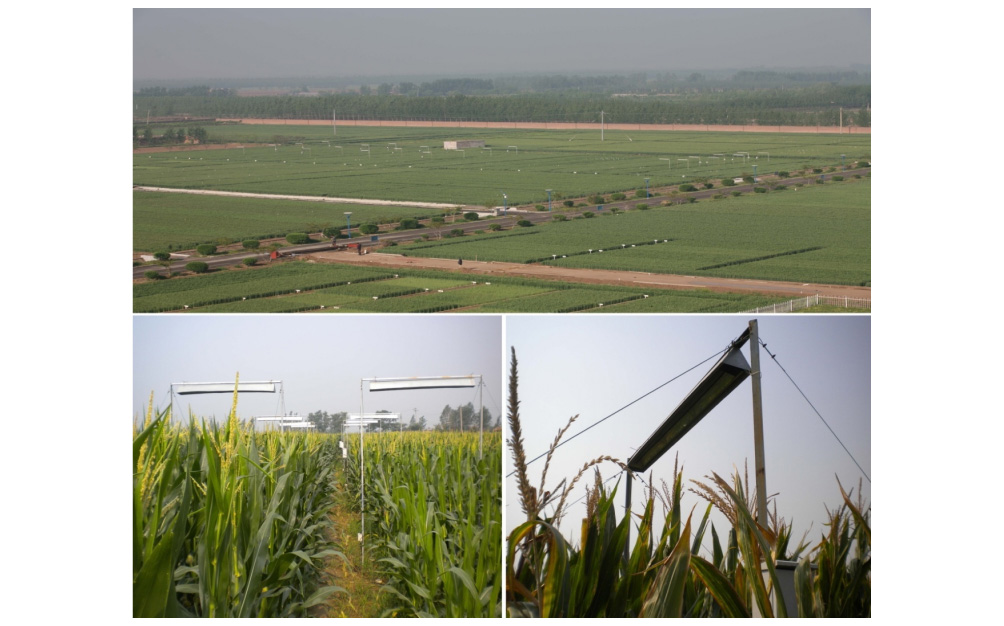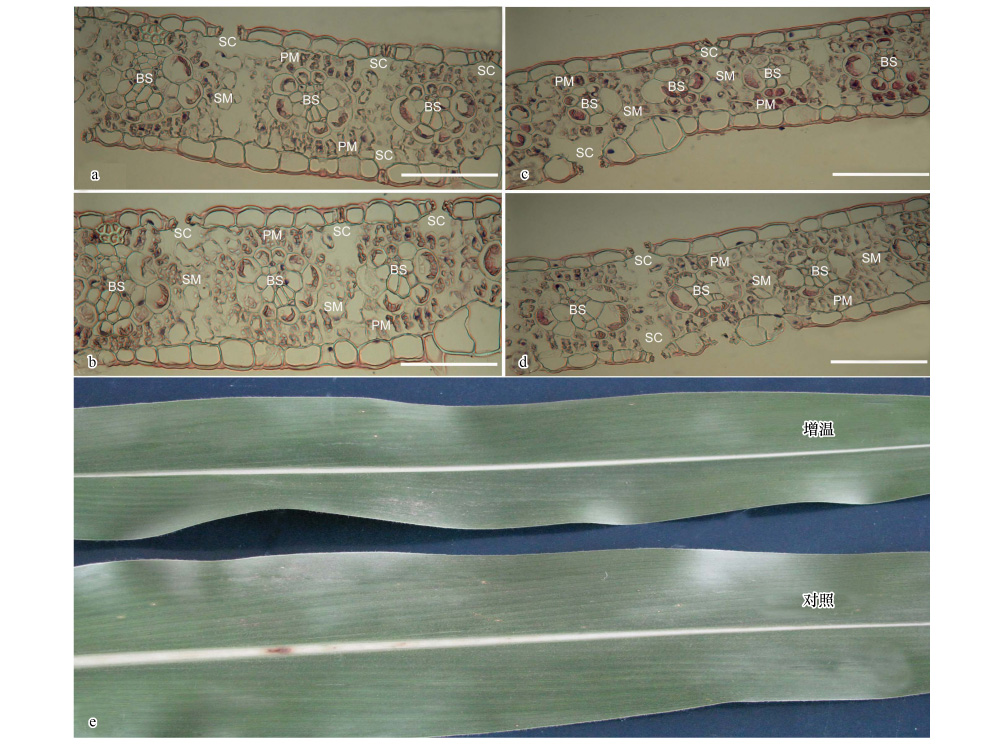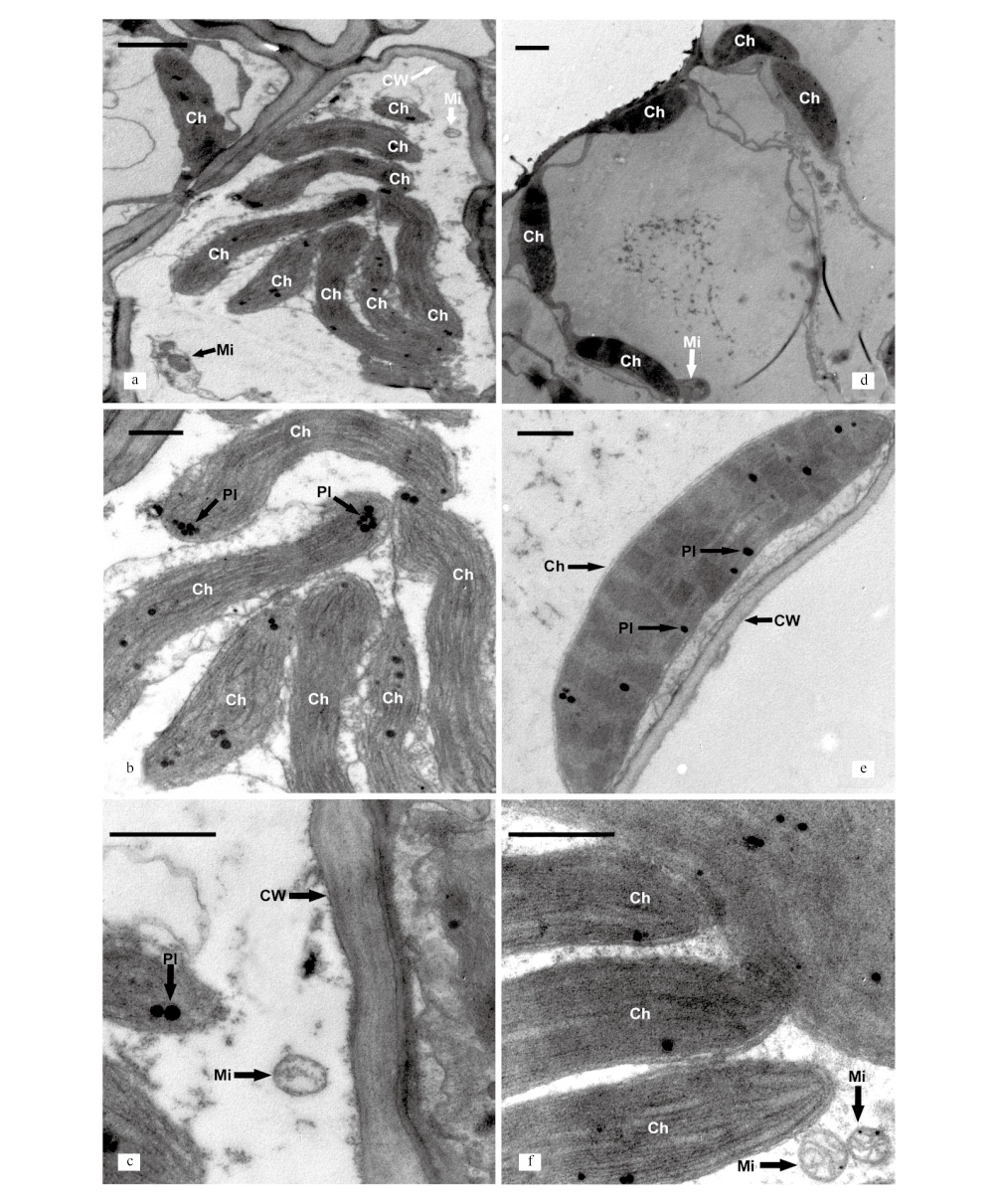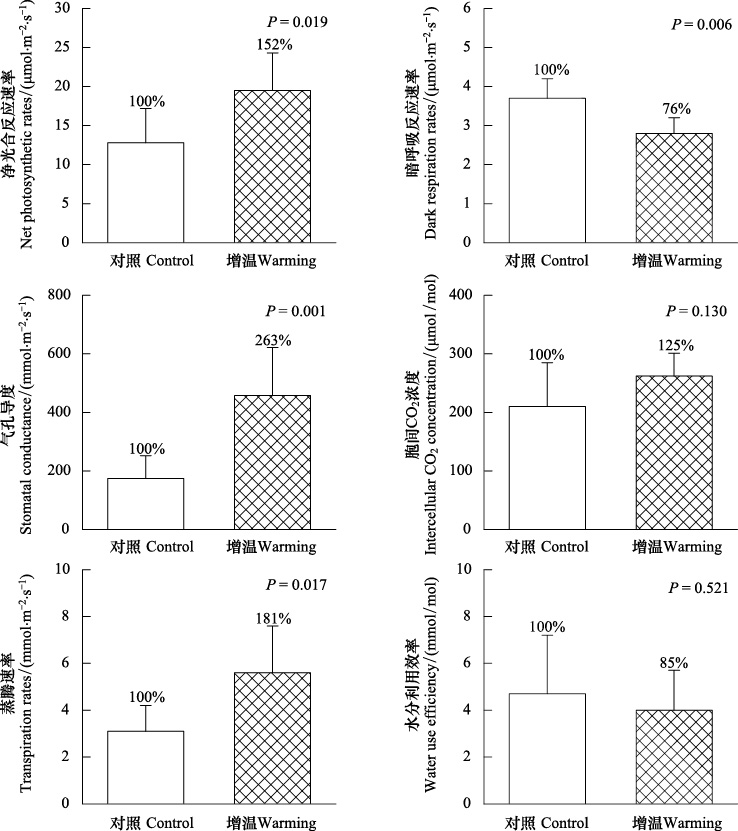文章信息
- 郑云普, 徐明, 王建书, 王贺新
- ZHENG Yunpu, XU Ming, WANG Jianshu, WANG Hexin
- 气候变暖对华北平原玉米叶片形态结构和气体交换过程的影响
- Effects of future climate warming on the morphology, structure, and gas exchange of maize leaves in the North China Plain
- 生态学报, 2016, 36(6): 1526-1538
- Acta Ecologica Sinica, 2016, 36(6): 1526-1538
- http://dx.doi.org/10.5846/stxb201408231669
-
文章历史
- 收稿日期: 2014-08-23
- 网络出版日期: 2015-07-29
2. 中国科学院地理科学与资源研究所生态系统网络观测与模拟重点实验室, 北京 100101;
3. 河北工程大学农学院, 邯郸 056038;
4. 大连大学现代农业研究院, 大连 116622
2. Key Laboratory of Ecosystem Network Observation and Modeling, Institute of Geographical Sciences and Natural Resources, Chinese Academy of Sciences, Beijing 100101, China;
3. School of agriculture, Hebei University of Engineering, Handan 056038, China;
4. Institute of Modern Agricultural Research, Dalian University, Dalian 116622, China
近年来的大量监测数据和模拟结果表明,自工业革命以来由于化石燃料燃烧、森林砍伐以及土地利用变化导致大气中温室气体(例如CH4、CO2及 NO2)的浓度显著增加[1]。同时,在过去的一个世纪中,升高的大气温室气体浓度已经导致全球地面平均温度上升约0.89℃,到本世纪末全球地表温度还将会上升1.5—2.0℃[1]。这种全球性的气候变暖势必影响到植物的形态结构和生理生态学特性[2, 3],进而对植物的种群、群落及生态系统甚至整个生物圈产生深远的影响[4, 5, 6, 7, 8]。以往许多模拟气候变暖的野外控制实验主要集中于北极冻原[7, 9, 10, 11, 12]、高山草甸[3, 13, 14, 15, 16, 17, 18]、温带草原[2, 19, 20, 21]等生态系统类型。然而,目前对于典型农田生态系统进行野外原位增温的相关实验研究较少[22]。许多气候模型已经证实我国的气候正在逐渐呈现变暖的趋势,特别是自从20世纪70年代以后我国北部地区(如华北平原)的气候呈现出年平均气温升高的特征[23, 24, 25, 26]。
通常来讲,全球气候变暖对植物功能的影响主要是通过间接影响土壤氮的矿化和有效性[27, 28, 29, 30]、土壤湿度[19, 31]及生长季的长度[32, 33, 34]或直接影响植物的生理代谢过程[17, 20, 35, 36, 37, 38, 39]。另外,全球气候变暖对植物功能的影响还可能来自于植物结构的改变,尤其是植物叶片结构的变化[40, 41, 42, 43]。许多的研究发现叶片厚度和叶肉体积与基于叶面积的碳同化速率[40, 42, 44]和比叶重[41, 45]之间具有很强的相关性。以往的研究结果表明,生长在高温环境下植物的叶片较薄,这主要是由于增温使表皮细胞体积减小从而引起表皮、栅栏组织层和海绵组织层变薄的原因[41, 45, 46]。早期的研究还发现叶绿体的数量和大小也同叶片光合速率存在着较高的相关性[41, 42]。例如,Jin等[41]观察到植物的生长温度增加2.5℃并没有改变单个细胞中叶绿体的数目;但是当植物的生长温度增加到5℃时,单个细胞内叶绿体的数目减少了22%(对照温度为白天/夜晚23/18℃);同时,该研究的结果还显示叶绿体的大小也随着生长温度的增加而减少。
华北平原是我国最重要的粮食产区之一,该区域主要以玉米和小麦轮作系统为主,每年全国大约50%的小麦和30%的玉米均产自于该粮食产区[26]。值得注意的是,全球变暖将会改变粮食作物的蒸散和水分利用效率[47, 48],并进一步改变农作物的生长和产量[48, 49, 50, 51]。以往的研究发现全球变暖已经导致了世界上许多地区粮食产量的减少[52]。近期的研究结果表明,气候变暖是农作物物候变化的主要驱动因子,气候变暖导致作物的开花期和成熟期提前,使得在气温升高的背景下,开花至成熟生长阶段的平均温度没有增加,虽然整个生育期呈缩短趋势,但作物产量形成的重要生长阶段,从作物开花至成熟阶段却呈现出延长的趋势[53]。另外,Hou 等[22]在华北平原对小麦进行实验增温的研究发现,气候变暖使小麦生长季缩短,但是其生育期并没有改变,导致免耕地小麦产量分别减少3.3%(2010年)和 6.1%(2011年)。
玉米(Zea mays L.) 是一种广泛分布的C4植物物种,同时也是世界上许多地区最重要的粮食作物之一[54, 55]。从这层意义上来讲,未来气候变暖对全球或者区域范围内玉米产量的影响直接关系到粮食供应的安全问题。然而,目前全球气候变暖对玉米产量造成影响的机理还并不清楚,这主要是由于气候变暖对玉米产量的影响过程极其复杂,不仅包括对玉米叶片功能的改变,还可能同时影响到叶片的形态和亚显微结构等诸多方面。因此,预测未来全球气候变暖对玉米产量的影响首先应该同时将叶片形态结构(解剖结构及亚显微结构)和叶片的功能(光合过程)结合起来考虑,全面系统的探讨全球变暖将会对玉米叶片形态结构特征和叶片功能之间关系产生的影响,这将有助于进一步深入理解未来气候变暖对玉米产量影响的潜在机理。本研究利用中国科学院禹城综合试验站的野外增温平台,深入探讨以下3个关键的科学问题:(1) 实验增温对玉米叶片形态结构特征产生的影响;(2)实验增温对玉米叶片气体交换过程产生的影响;(3) 实验增温对玉米叶片形态结构和生理特性之间关系的影响。
1 材料与方法 1.1 研究区概况本研究在中国科学院禹城综合试验站 (36°57′N,116°38′E,海拔 23.4 m) 完成。该站位于山东省禹城市,属大陆性季风气候暖温带地区。年平均气温 13.1℃,1 月平均温度 -3℃,7月平均温度26.9℃;年平均降水量610mm,降水季节分配不均匀,3—5月平均降水量75.7mm,占年平均降水量的12.4%;6—8月降水量平均为419.7 mm,占年平均降水量的68.8%。实验站土壤质地以粉砂和轻壤为主;pH值较高,为7.9—8.0;土壤有机质含量较低,为0.6%—1.0%;全N含量为 0.05%—0.065%[56]。从土壤自然条件看,该站在华北平原具有典型代表性。当地种植制度以冬小麦-夏玉米轮作为主。
1.2 野外增温实验设计在2009年9月份,在试验区随机选取6个2m×3m 的样方用以布置增温实验。随机选取其中的3个样方作为增温组,另3个为对照组。3个增温样方从2009年11月18日开始利用悬挂于样方正上方距离地表 2.25m高度的MSR-2420型红外发射器(165×1.5 cm,Kalglo Electronics Inc.,Bethlehem,PA)进行连续的增温处理 (图 1)。每个对照样方内同样在距离地面2.25m高度处悬挂一个相同大小和形状的“伪”红外增温装置模拟红外发射器对下方土壤产生阴影的效果。增温样方和对照样方相距约5m,避免红外增温装置对对照样方产生影响。利用PT100热电偶系统(Unism Technologies Incorporated,Beijing,China)自动记录每小时2.25m高度处的空气温度和5cm深处的土壤温度。另外,在本研究中还利用红外温度计(FLUKE 574,Fluke Inc.,USA) 测量玉米冠层叶片表面的温度。在整个玉米生长季从2011年6月24日到2011年10月7日,相对于对照样地,增温样地平均的空气温度、土壤温度、灌层温度分别增加了(1.42±0.18)/(1.77±0.24)℃(白天/夜晚)、(1.68±0.9)/(2.04±0.16)℃(白天/夜晚)、(2.08±0.72)℃(白天)。同时,本实验还利用FDS100土壤湿度传感器 (Unism Technologies Incorporated,Beijing,China)监测了样方内0—10cm深度土壤湿度的变化状况。在整个监测时期,对照样地10cm 深处土壤湿度为26%,而增温样地10cm 深处土壤湿度为25%[22]。

|
| 图1 华北平原典型农田生态系统实验增温样地 Fig.1 The experimental warming site in a typical agriculture ecosystem in the China Northern Plain |
优良玉米品种 (Zea mays L.cv. Zhengdan958)的种子播种之前先在黑暗、干燥的环境下4℃冷藏2 d。随后,2011年6月24日将玉米种子分别播种到增温和对照样地,增温和对照样地的玉米苗均于7月1日出苗。为了避免干旱胁迫,利用地下水在整个生长季从2011年6月24日到2011年10月7日对各个样地的玉米苗灌溉。随机从增温和对照样地中选取1个样地取样。由于玉米穗位叶是决定玉米产量最重要的叶片,因此在玉米播种60 d后(即2011年8月24日)在所选的采样样地各随机采集5个完全伸展的穗位叶进行各个指标的测量和观察。
1.4 实验方法 1.4.1 玉米叶片形态及解剖结构观测利用直尺对上述选取的5棵玉米植株的穗位叶分别测量叶片长度和叶片宽度。另外,选取叶片中部位置采集玉米叶片样品用于内部解剖结构的观察和测量。样品采集后迅速放入体积2.5%的戊二醛固定液中保存并尽快运回实验室进行处理。利用石蜡切片的实验方法在光学显微镜下观察叶片组织的内部解剖结构。本研究按照Sage和Williams的方法[57]取叶片中部的组织制作叶片横切的石蜡切片,然后在显微镜下观察并拍照。根据所拍照片利用Image J 软件(NIH,USA)定量研究叶片内部结构特征。叶肉厚度定义为叶片横切面上下表皮之间的距离。由于同一叶片的叶肉厚度也可能不均匀,对于叶肉厚度的测量采用对每个横切面不同位置的上下表皮之间测量5次,将5次测量值的平均值作为该横切面的叶肉厚度。本研究将相邻两个维管束鞘之间的距离定义为鞘间距。对玉米叶片内鞘间距大小的测量为相邻2个维管束鞘的距离[58]。叶片中叶肉或维管组织所占比例+随机生成200个点的方法计算,由这200个随机点所处的的叶肉组织或维管组织的比例代表了叶片横切面两种组织所占的比例[59, 60, 61]。
1.4.2 玉米叶片亚显微结构观测将采集的玉米叶片样品(2 mm×2 mm)用体积2.5%的戊二醛固定液(0.1 mol/L磷酸缓冲液,pH值 7.0)迅速固定,然后放到4℃环境下冷藏保存,并立即将样品运回实验室做进一步的处理。在实验室内样品用相同浓度的磷酸缓冲液冲洗6次,并在室温环境下用体积1%的锇酸固定3 h,然后再用同样的磷酸缓冲液冲洗干净。随后植物样品要经过不同浓度梯度的酒精脱水、树脂渗透、包埋等过程。利用LKB-V 型超薄切片机切片,醋酸双氧铀和柠檬酸铅染色,然后在透射电子显微镜( JEOL Ltd,Tokyo,Japan)下观察叶片组织的叶绿体和线粒体等亚显微结构观察并拍照。
1.4.3 玉米叶片气体交换参数测量本研究中对于玉米叶片气体交换参数的测量在2011年8月24日9:00—11:00之间进行。分别在对照和增温样地中随机选取5个玉米植株的穗位叶,在该叶片的中间位置利用Li-6400便携式光合测定系统(LI-COR Inc. Lincoln,Nebraska,USA)来测定其净光合速率、气孔导度和蒸腾速率等气体交换参数。同Li-6400便携式光合测定系统配套使用的2cm×3cm 标准气室能独立控制光合光量子通量密度 (PPFD)、CO2浓度、叶片温度及气室湿度。对于玉米叶片气体交换参数测点时设定叶室内的光照强度为1500μmol m-2s-1PAR,VPD为2.0 KPa,CO2浓度为380μmol/mol,叶片温度为25℃。
1.5 数据统计分析本研究中关于增温对叶片形态解剖结构和亚显微结构的影响利用t-test进行统计分析。本研究中的统计分析均利用SPSS 13.0 (Chicago,IL)统计软件完成,利用Sigmaplot完成作图。
2 结果与分析 2.1 增温对玉米叶片形态和解剖结构的影响本研究结果显示,增温显著减小了玉米叶片的宽度和厚度(P<0.05),但并没有影响叶片的长度(表 1)。另外,增温还同时显著减少了叶肉厚度约10%。由于对照和增温叶片细胞的平均层数没有显著区别,叶肉厚度的减少主要是由细胞面积变小造成的(表 1)。增温减小相邻维管束间的距离10%,并减少了维管束面积约30%,导致增温环境下的玉米叶片具有更多的、小的维管束(表 1,图 2)。相对于环境温度,增温并没有明显改变维管束鞘(BS)细胞的大小(表 1,图 2)。另外,增温导致叶肉细胞面积减小22%,这主要是由于栅栏组织细胞面积的显著减少引起的,因为增温并没有影响海绵组织细胞的面积。然而,对照和增温环境下叶肉细胞与维管束鞘细胞面积的比例并没有显著的差异。相似地,尽管增温显著增加叶片中叶肉组织所占比例(M%)约13%,但是维管束鞘细胞所占的比例(BS%)以及叶肉组织/维管束鞘细胞组织的比例均没有在增温环境下发生显著的变化(表 1)。此外,增温还减小了细胞壁厚度30%但并没有影响气孔下腔的面积 (表 1,图 2)。
| 参数Parameter | 对照Control | 增温Warming | 增量Increase/% | P |
| 形态数据Morphological data | ||||
| 叶片长度Leaf length/cm | 78.4±3.1 | 79.9±2.2 | 1.9 | 0.256 |
| 叶片宽度Leaf width/cm | 10.2±0.7 | 9.8±0.6 | -3.9 | 0.017 |
| 叶片厚度Leaf thickness/μm | 167±11 | 150±25 | -10.2 | <0.0001 |
| 解剖数据Anatomical data | ||||
| 叶肉厚度Mesophyll thickness/μm | 122±11 | 110±20 | -9.8 | 0.001 |
| 细胞层数Number of cell layer | 8.1±0.7 | 8.6±0.8 | 6.2 | 0.068 |
| 脉间距 Interveinal distance/μm | 122±19 | 109±29 | -10.7 | 0.027 |
| 维管束鞘面积Vascular bundle area/μm2 | 4946±1251 | 3538±1568 | -28.5 | 0.001 |
| 气孔下腔面积 Sub-stomatal cavity area/μm2 | 742±271 | 761±344 | 2.6 | 0.851 |
| 栅栏组织细胞面积 Palisade mesophyll cell area/μm2 | 374±81 | 246±153 | -52.0 | <0.0001 |
| 海绵组织细胞面积 Spongy mesophyll cell area/μm2 | 226±88 | 216±85 | -4.4 | 0.525 |
| 叶肉细胞面积 Mesophyll cellarea/μm2 | 297±57 | 231±91 | -22.2 | <0.0001 |
| 维管束鞘细胞面积 Bundle sheath cell area/μm2 | 487±225 | 459±170 | -5.8 | 0.446 |
| 叶肉:维管束鞘Mesophyll: bundle sheath | 0.79±0.42 | 0.64±0.37 | -20.0 | 0.093 |
| %叶肉组织 Mesophyll/% | 51.9±7.4 | 45.2±7.7 | -12.9 | 0.010 |
| %维管束鞘组织 Bundle sheath/% | 28.1±5.3 | 27.8±5.8 | -1.1 | 0.872 |
| 叶肉:维管束鞘Mesophyll: bundle sheath | 1.9±0.5 | 1.7±0.6 | -10.5 | 0.270 |
| 细胞壁厚度 Cell wall thickness/μm2 | 0. 6±0.1 | 0.4±0.1 | -31.5 | 0.031 |
| 细胞器数据Organelle data | ||||
| 叶绿体长度 Chloroplast length/μm | 6.1±1.2 | 8.9±0.9 | 45.9 | <0.0001 |
| 叶绿体宽度Chloroplast width/μm | 1.4±0.2 | 2.1±0.2 | 50.0 | <0.0001 |
| 叶绿体剖面面积 Chloroplast profile area/μm2 | 6.3±1.1 | 15.2±1.4 | 141.3 | <0.0001 |
| 细胞内叶绿体数Chloroplast number per cell | 8.8±2.6 | 11.8±2.4 | 22.7 | 0.240 |
| 叶绿体内质体小球数Plastoglobulis per chloroplast | 8.6±1.1 | 9.9±1.8 | 15.3 | 0.151 |
| 线粒体大小 Mitochondrial area/μm2 | 0.17±0.04 | 0.26±0.06 | 52.9 | 0.01 |
| 表中数值为平均值±标准差,分别从对照和处理中选取5个玉米植株的穗位叶,进行各个指标的观察和测量;对于叶片的解剖结构和亚显微结构,每个叶片至少观察和测量100个细胞。所有数据利用Student′s t-test在0.05水平上进行比较 | ||||

|
| 图2 增温对玉米叶片形态及解剖结构的影响 Fig.2 Effects of experimental warming on the morphology and anatomical structures of maize leaves a和b: 对照叶片的解剖结构;c和d: 增温处理叶片的解剖结构; BS: 维管束鞘;SC: 气孔下腔;PM: 栅栏组织;SM: 海绵组织; 图中标尺代表 100 μm |
实验增温不仅改变了玉米叶片的形态和解剖结构,同时还对玉米叶片内叶绿体和线粒体等细胞器的亚显微结构产生了影响。相对于对照组的玉米叶片,增温分别平均增加了叶绿体长度和宽度46%和50%,导致叶绿体的剖面面积显著增加140% (表 1,图 3a)。然而,增温对每个叶肉细胞内的叶绿体数目和每个叶绿体内质体小球的数目没有产生影响(表 1,图 3b和e)。另外,增温显著增加了线粒体的大小约53% (表 1,图 3c和f)。

|
| 图3 增温对玉米叶片亚显微结构的影响 Fig.3 Effects of experimental warming on the ultrastructures of maize leaves a—c: 环境温度条件下叶片解剖结构;d—f: 增温条件下的叶片解剖结构; 通过显微照片观察到增温显著增加了叶绿体及线粒体的面积,但减小了细胞壁的厚度; Ch: 叶绿体;Mi: 线粒体;CW: 细胞壁;Pl: 脂体小球; 标尺: 2 μm (a和d) 或1μm (b—c和e—f) |
实验增温不仅改变了玉米叶片的形态和和结构还对其气体交换参数产生了显著的影响(图 4)。增温显著增加了玉米叶片的净光合反应速率(Pn)、气孔导度(Gs)和蒸腾速率(Tr),然而却显著降低了玉米叶片的暗呼吸速率(Rd),但是并没有显著改变叶片的细胞间CO2浓度(Ci)和水分利用效率(WUE)。研究结果显示,实验增温使玉米叶片的净光合反应速率(Pn)从12.8 μmol m-2s-1到19.5 μmol m-2s-1显著增加了52%;同时,玉米叶片的气孔导度(Gs)和蒸腾速率(Tr)也分别显著增加了163%和81%。然而,实验增温却显著降低玉米叶片暗呼吸速率(Rd)高达24%。此外,本研究结果还显示实验增温增加了玉米叶片的细胞间CO2浓度(Ci) 25%,却同时降低了叶片水分利用效率(WUE)15%,但是该影响并没有达到显著水平(图 4)。

|
| 图4 增温对玉米叶片气体交换参数的影响 Fig.4 Effects of experimental warming on the gas exchangeparameters of maize leaves |
以往关于叶片光合作用过程对增温响应的研究结果还存在较大的争议[62, 63, 64]。例如,一些研究报道增温对叶片光合速率没有影响[35, 64, 65, 66, 67, 68],而另一些研究却发现增温降低了叶片的光合速率[63, 69, 70],还有的研究则认为增温会增加叶片的光合速率[15, 17, 41, 71]。本研究的结果也表明,增温显著增加了玉米叶片的净光合速率(P<0.001,图 4)。
目前,叶片内部解剖结构变化在光合过程对温度响应中所起的作用是全球变化生态学领域还未解决的一个关键的科学问题[43]。通常,叶片的解剖结构对于植物光合过程的调控方面起着极其关键的作用,这主要是由于叶片的解剖结构不仅紧密联系着整个植物的功能和生长而且对于外界环境条件(例如温度)也非常的敏感[40, 72]。因此,气候变化背景下叶片解剖结构的变化也可能通过改变CO2从大气扩散到光合位点的途径来影响植物光合过程对气候变化的响应。C4植物与C3 植物碳同化途径的区别主要是C4植物的光合作用过程是在维管束鞘细胞中进行的。当CO2分子经过气孔扩散到叶片内部后,C4植物通过叶肉细胞的PEP羧激酶固定CO2,生成的C4酸转移到维管束鞘薄壁细胞中,再次放出CO2,参与卡尔文循环,最终形成糖类物质。本研究中对玉米叶片解剖结构的研究发现,增温分别减少了玉米叶片脉间距和维管束鞘的面积约10%和30%;也就是说增温导致玉米叶片内维管束鞘的面积变小,数量增多 (表 1)。同时,我们也直接观察到增温环境下的玉米叶片与对照相比具有更多、更小的维管束鞘 (图 2)。更有趣的是,Xu等[42]对桉树的实验研究结果也发现增温分别减少叶片维管束的宽度和长度18%和22%。因此,这种增温导致植物叶片内产生更多的、更小的维管束鞘可能对于C4植物叶片碳同化效率的提高具有非常重要的意义。这主要是由于玉米叶片内更多的、更小的维管束鞘能够有效缩短叶肉细胞内由PEP羧激酶固定CO2生成的C4酸从叶肉细胞通过胞间连丝转移到维管束鞘细胞的距离,这同时在一定程度上也减小了其转移过程中受到的叶肉阻力,有效提高维管束鞘内参与碳同化过程的CO2浓度,最终可能会体现在增温条件下的植物叶片具有较高的净光合速率[18]。本研究的结果表明,单位叶面积内更多小型的维管束鞘可能使大气CO2由气孔进入玉米叶片到达维管束鞘的距离缩短,这将会在一定程度上减小CO2气体扩散到达叶绿素光合位点的叶肉阻力,提高CO2在光合位点的同化效率,最终表现在增温条件下的玉米叶片具有较高的光合速率 (图 4)。
关于增温对叶片结构分析的工作在许多的温度下开展,但是大多数研究主要关注植物对冷胁迫或者热胁迫的响应,很少有研究关注非胁迫生长温度下植物叶片结构对温度的响应,并且这些研究的结论也并不一致[73]。植物叶片厚度的改变反映出其解剖结构的变化,例如栅栏组织层数目和大小的变化[41, 42, 43]。许多在非胁迫生长温度下(10—30℃)开展的研究发现,对于同一个物种生长在高温条件下具有较薄的叶片,但这主要是由于表皮层厚度、海面和栅栏组织层厚度的减小或者是叶肉细胞大小的减小而造成的[41, 44, 45, 46]。另外,以往的大多数研究也认为增温可能会减小植物叶片的厚度[18, 41, 42, 74]。例如,Jin等[41]发现增温显著减少拟南芥叶片厚度8%。相似地,Yang等[42]在我国青藏高原上的增温实验研究发现增温减少了该区域优势种亚高山莎草(Kobresia pygmaea) 叶片厚度10%。然而,Smith等[43]的研究却发现增温并没有对铁木桉(Eucalyptus sideroxylon)的叶片厚度、叶肉厚度以及表皮厚度产生影响。本研究的结果显示,增温减少了华北平原玉米叶片的厚度约10%,这与以往的研究结果基本一致[41, 42]。对叶片解剖结构的进一步观察和测量后发现,叶片厚度的减少主要是由于增温环境下叶肉组织变薄所导致的。更有趣的是进一步的研究发现,叶肉细胞的层数没有改变,叶肉组织变薄的原因主要是由于增温显著减小了叶肉细胞的面积。另外,本文的研究结果还显示,增温显著减少了叶肉组织中栅栏组织细胞的面积52%,但对海绵组织的细胞面积却几乎没有产生影响。本研究的结果表明,未来气候变暖可能通过减少海绵组织细胞的面积来减少玉米叶片的厚度。更进一步来讲,本研究中实验增温条件下玉米叶片厚度的减少可能更加有利于其散失过高的热量,从而避免叶片内部的细胞器和组织受到高温的伤害,这或许是该C4物种适应未来全球气候变暖的一个有效的方法和措施。
叶绿体是植物进行光合作用的细胞器,叶绿体的结构和数量同植物光合速率之间存在着非常密切的关系[41, 42]。早期的研究结果已经发现细胞内叶绿体的数量同光合速率之间存在着很好的相关性关系[41]。以往的研究观察到生长在高CO2浓度或高温环境下的植物与对照相比具有较高叶片光合速率的同时单个细胞内也具有较多的叶绿体数量[43]。然而,目前关于增温对叶绿体大小和数量影响并没有一致的结论。例如,Jin等[41]观察到拟南芥的生长温度增加2.5℃并没有改变单个细胞中叶绿体的数目;但是当植物的生长温度增加到5℃时,单个细胞内叶绿体的数目减少了22%(对照温度为白天/夜晚23/18℃)。同时,该研究的结果还显示叶绿体的大小也随着生长温度的增加而减小。Xu等[42]探讨了增温对铁树桉(Eucalyptus saligna)细胞内叶绿体大小和数目的影响,研究结果显示增温显著减少了每个细胞内叶绿体的数量但并没有改变叶绿体的大小。然而,更有趣的是本研究的结果显示,增温显著增加了玉米叶片内叶绿体的大小,但并没有改变每个细胞内的叶绿体数目(表 1)。以往研究结论的不一致可能是有以下两个方面原因造成的。(1) 不同物种对增温的响应方式不一样。植物为了响应周围的环境变化势必在结构方面做出一些调整,进一步改变叶片功能,例如光合作用。这些调整包括对于每个细胞内叶绿体的大小和数量的改变。然而,不同物种在对叶绿体进行调整时所采取的策略可能存在着差异。有些物种可能通过改变叶绿体数目的方式来调整,而有些物种则可能通过改变叶绿体的大小的方式进行调整。(2) 不同研究中增温强度的差异也可能是导致叶绿体调整方式改变的原因。例如,Jin 等[41]的研究中发现植物生长温度增加5℃时拟南芥单个细胞内的叶绿体数目显著减少,但当生长温度增加2.5℃时却没有影响到叶绿体树木的变化。同样,Xu等[42]的研究是将铁树桉生长温度提高4℃时发现增温改变了每个细胞内叶绿体的数量。然而,本研究在野外利用红外线对玉米叶片的增温幅度仅为2℃,同Jin等[41]和Xu等[42]的研究相比增温强度低,增温信号较弱,这也可能是本研究中没有改变叶绿体数目的原因之一。然而,在本研究中还发现,尽管增温并没有改变每个细胞中叶绿体的数目,但是却导致叶绿体的大小发生了变化。总之,本研究的结果表明当植物生长环境的温度增加幅度较小时植物体主要通过调整叶绿体的大小来适应环境变化,但是当其生长环境的温度变化较大时,可能仅通过调整叶绿体的大小并不足以适应外界的环境,因此选择另外一种更加有效的调整方式即改变叶绿体的数目来达到适应的目的。
综上所述,未来气候变暖可能会对农田生态系统的结构和功能产生深远的影响。以往的研究已经发现,气候变暖能够对农田生态系统作物昆虫的行为[75, 76, 77, 78]、种间关系[79, 80]、食物链及食物网的结构[82]产生直接的影响。除了全球变暖对农田昆虫的直接影响之外,全球范围内的增暖还可能会通过改变寄主植物叶片的次生代谢物成分和种类来间接影响昆虫的生长、发育及繁殖,从而改变昆虫的种间关系和食物链的结构[76, 80]。本研究的结果表明,未来全球变暖情境下,我国华北平原地区玉米叶片将会从形态、结构 (解剖结构及亚显微结构) 到功能 (例如光合及呼吸等关键生理过程)方面都进行统一的响应和调整。然而,即使生态系统自身能够做出这样的调整,未来我国华北平原地区的玉米作物仍然可能面临全球气候变暖造成农作物减产的巨大风险。因此,未来气候变暖背景下对于华北平原农田生态系统进行科学有效的管理的时候,应该全面考虑上述对该生态系统产生影响的诸多方面,以期能够有效地预防和适应气候变暖可能带来的不利影响。
| [1] | IPCC. Technical summary//Solomon S, Qin D, Manning M, Chen Z, Marquis M, Averyt K B, Tignor M, Miller H L, eds. Climate Change 2007: The Physical Science Basis. Contribution of Working Group I to the Fourth Assessment Report of the Intergovernmental Panel on Climate Change. Cambridge UK: Cambridge University Press, 2007. |
| [2] | Niu S L, Wan S Q. Warming changes plant competitive hierarchy in a temperate steppe in northern China. Journal of Plant Ecology, 2008, 1(2): 103-110. |
| [3] | Zhao C Z, Liu Q. Growth and physiological responses of Picea asperata seedlings to elevated temperature and to nitrogen fertilization. Acta Physiologiae Plantarum, 2009, 31(1): 163-173. |
| [4] | Klein J A, Harte J, Zhao X Q. Experimental warming causes large and rapid species loss, dampened by simulated grazing, on the Tibetan Plateau. Ecology Letters, 2004, 7(12): 1170-1179. |
| [5] | Walker M D, Wahren C H, Hollister R D, Henry G H R, Ahlquist L E, Alatalo J M, Bret-Harte M S, Calef M P, Callaghan T V, Carroll A B, Epstein H E, Jonsdottir I S, Klein J A, Magnusson B, Molau U, Oberbauer S F, Rewa S P, Robinson C H, Shaver G R, Suding K N, Thompson C C, Tolvanen A, Totland Ø, Turner P L, Tweedie C E, Webber P J, Wookey P A. Plant community responses to experimental warming across the tundra biome. Proceedings of the National Academy of Sciences of the United States of America, 2006, 103(5): 1342-1346. |
| [6] | Franco A M A, Hill J K, Kitschke C, Collingham Y C, Roy D B, Fox R, Huntley B, Thomas C D. Impacts of climate warming and habitat loss on extinctions at species' low-latitude range boundaries. Global Change Biology, 2006, 12(8): 1545-1553. |
| [7] | Biasi C, Meyer H, Rusalimova O, Hämmerle R, Kaiser C, Baranyi C, Daims H, Lashchinsky N, Barsukov P, Richter A. Initial effects of experimental warming on carbon exchange rates, plant growth and microbial dynamics of a lichen-rich dwarf shrub tundra in Siberia. Plant and Soil, 2008, 307(1-2): 191-205. |
| [8] | Jägerbrand A K, Alatalo J M, Chrimes D, Molau U. Plant community responses to 5 years of simulated climate change in meadow and heath ecosystems at a subarctic-alpine site. Oecologia, 2009, 161(3): 601-610. |
| [9] | Chapin F S Ⅲ, Shaver G R. Physiological and growth responses of arctic plants to a field experiment simulating climatic change. Ecology, 1996, 77(3): 822-840. |
| [10] | Hobbie S, Chapin F S Ⅲ. The response of tundra plant biomass, aboveground production, nitrogen, and CO2 flux to experimental warming. Ecology, 1998, 79(5): 1526-1544. |
| [11] | Tolvanen A, Henry G H R. Responses of carbon and nitrogen concentrations in high arctic plants to experimental warming. Canadian Journal of Botany, 2001, 79(6): 711-718. |
| [12] | Epstein H E, Calef M P, Walker M D, Chapin F S III, Starfield A M. Detecting changes in arctic tundra plant communities in response to warming over decadal time scales. Global Change Biology, 2004, 10(8): 1325-1334. |
| [13] | Kudo G, Suzuki S. Warming effects on growth, production, and vegetation structure of alpine shrubs: a five-year experiment in northern Japan. Oecologia, 2003, 135(2): 280-287. |
| [14] | Klein M, Geisler M, Suh S J, Kolukisaoglu H V, Azevedo L, Plaza S, Curtis M D, Richter A, Weder B, Schulz B, Martinoia E. Disruption of AtMRP4, a guard cell plasma membrane ABCC-type ABC transporter, leads to deregulation of stomatal opening and increased drought susceptibility. The Plant Journal, 2004, 39(2): 219-236. |
| [15] | Yin H J, Liu Q, Lai T. Warming effects on growth and physiology in the seedlings of the two conifers Picea asperata and Abies faxoniana under two contrasting light conditions. Ecological Research, 2008, 23(2): 459-469. |
| [16] | Xu Z F, Hu T X, Wang K Y, Zhang Y B, Xian J R. Short-term responses of phenology, shoot growth and leaf traits of four alpine shrubs in a timberline ecotone to simulated global warming, Eastern Tibetan Plateau, China. Plant Species Biology, 2009, 24(1): 27-34. |
| [17] | Han C, Liu Q, Yang Y. Short-term effects of experimental warming and enhanced ultraviolet-B radiation on photosynthesis and antioxidant defense of Picea asperata seedlings. Plant Growth Regulation, 2009, 58(2): 153-162. |
| [18] | Yang Y, Wang G X, Klanderud K, Yang L D. Responses in leaf functional traits and resource allocation of a dominant alpine sedge (Kobresia pygmaea) to climate warming in the Qinghai-Tibetan Plateau permafrost region. Plant and Soil, 2011, 349(1-2): 377-387. |
| [19] | Wan S Q, Hui D F, Wallace L, Luo Y Q. Direct and indirect effects of experimental warming on ecosystem carbon processes in a tallgrass prairie. Global Biogeochemical Cycles, 2005, 19(2): GB2014, doi: 10.1029/2004GB002315. |
| [20] | Niu S L, Li Z X, Xia J Y, Han Y, Wu M Y, Wan S Q. Climatic warming changes plant photosynthesis and its temperature dependence in a temperate steppe of northern China. Environmental and Experimental Botany, 2008, 63(1-3): 91-101. |
| [21] | Chi Y G, Xu M, Shen R C, Yang Q P, Huang B R, Wan S Q. Acclimation of foliar respiration and photosynthesis in response to experimental warming in a temperate steppe in northern China. PloS ONE, 2013, 8(2): e56482. |
| [22] | Hou R X, Ouyang Z, Li Y S, Wilson G V, Li H X. Is the change of winter wheat yield under warming caused by shortened reproductive period? Ecology and Evolution, 2012, 2(12): 2999-3008. |
| [23] | Lin E D. Agricultural vulnerability and adaptation to global warming in China. Water, Air, and Soil Pollution, 1996, 92(1-2): 63-73. |
| [24] | Smit B, Cai Y L. Climate change and agriculture in China. Global Environmental Change, 1996, 6(3): 205-214. |
| [25] | Chen L X, Zhu W Q, Wang W, Zhou X J, Li W L. Studies on climate change in China in recent 45 years. Acta Meteorologica Sinica, 1998, 56(3): 257-271. |
| [26] | Tao F L, Yokozawa M, Xu Y L, Hayashi Y, Zhang Z. Climate changes and trends in phenology and yields of field crops in China, 1981-2000. Agricultural and Forest Meteorology, 2006, 138(1-4): 82-92. |
| [27] | Rustad L, Campbell J, Marion G, Norby R, Mitchell M, Hartley A, Cornelissen J, Gurevitch J. A meta-analysis of the response of soil respiration, net nitrogen mineralization, and aboveground plant growth to experimental ecosystem warming. Oecologia, 2001, 126(4): 543-562. |
| [28] | Peñuelas J, Gordon C, Llorens L, Nielsen T, Tietema A, Beier C, Bruna P, Emmett B, Estiarte M, Gorissen A. Nonintrusive field experiments show different plant responses to warming and drought among sites, seasons, and species in a north-south European gradient. Ecosystems, 2004, 7(6): 598-612. |
| [29] | Sardans J, Peñuelas J, Estiarte M, Prieto P. Warming and drought alter C and N concentration, allocation and accumulation in a Mediterranean shrubland. Global Change Biology, 2008, 14(10): 2304-2316. |
| [30] | Sardans J, Peñuelas J, Prieto P, Estiarte M. Drought and warming induced changes in P and K concentration and accumulation in plant biomass and soil in a Mediterranean shrubland. Plant and Soil, 2008, 306(1-2): 261-271. |
| [31] | Holsten A, Vetter T, Vohland K, Krysanova V. Impact of climate change on soil moisture dynamics in Brandenburg with a focus on nature conservation areas. Ecological Modeling, 2009, 220(17): 2076-2087. |
| [32] | Menzel A, Fabian P. Growing season extended in Europe. Nature, 1999, 397(6721): 659. |
| [33] | Walther G R, Post E, Convey P, Menzel A, Parmesan C, Beebee T J C, Fromentin J M, Hoegh-Guldberg O, Bairlein F. Ecological responses to recent climate change. Nature, 2002, 416(6879): 389-395. |
| [34] | Cleland E E, Chiariello N R, Loarie S R, Mooney H A, Field C B. Diverse responses of phenology to global changes in a grassland ecosystem. Proceedings of the National Academy of Sciences of the United States of America, 2006, 103(37): 13740-13744. |
| [35] | Llorens L, Peñuelas J, Estiarte M, Bruna P. Contrasting growth changes in two dominant species of a Mediterranean shrubland submitted to experimental drought and warming. Annals of Botany, 2004, 94(6): 843-853. |
| [36] | Albert K R, Ro-Poulsen H, Mikkelsen T N, Michelsen A, van der Linden L, Beier C. Interactive effects of elevated CO2, warming, and drought on photosynthesis of Deschampsia flexuosa in a temperate heath ecosystem. Journal of Experimental Botany, 2011, 62(12): 4253-4266. |
| [37] | Prieto P, Peñuelas J, Llusià J, Asensio D, Estiarte M. Effects of long-term experimental night-time warming and drought on photosynthesis, Fv/Fm and stomatal conductance in the dominant species of a Mediterranean shrubland. Acta Physiologiae Plantarum, 2009, 31(4): 729-739. |
| [38] | Tjoelker M G, Reich P B, Oleksyn J. Changes in leaf nitrogen and carbohydrates underlie temperature and CO2 acclimation of dark respiration in five boreal tree species. Plant, Cell and Environment, 1999, 22(7): 767-778. |
| [39] | Zha T S, Ryyppö A, Wang K Y, Kellomäki S. Effects of elevated carbon dioxide concentration and temperature on needle growth, respiration and carbohydrate status in field-grown Scots pines during the needle expansion period. Tree Physiology, 2001, 21(17): 1279-1287. |
| [40] | Niinemets U, Díaz-Espejo A, Flexas J, Galmés J, Warren C R. Role of mesophyll diffusion conductance in constraining potential photosynthetic productivity in the field. Journal of Experimental Botany, 2009, 60(8): 2249-2270. |
| [41] | Jin B, Wang L, Wang J, Jiang K Z, Wang Y, Jiang X X, Ni C Y, Wang Y L, Teng N J. The effect of experimental warming on leaf functional traits, leaf structure and leaf biochemistry in Arabidopsis thaliana. BMC Plant Biology, 2011, 11: 35. |
| [42] | Xu C Y, Salih A, Ghannoum O, Tissue D T. Leaf structural characteristics are less important than leaf chemical properties in determining the response of leaf mass per area and photosynthesis of Eucalyptus saligna to industrial-age changes in [CO2] and temperature. Journal of Experimental Botany, 2012, 63(16): 5829-5841. |
| [43] | Smith R A, Lewis J D, Ghannoum O, Tissue D T. Leaf structural responses to pre-industrial, current and elevated atmospheric [CO2] and temperature affect leaf function in Eucalyptus sideroxylon. Functional Plant Biology, 2012, 39(4): 285-296. |
| [44] | Higuchi H, Sakuratani T, Utsunomiya N. Photosynthesis, leaf morphology, and shoot growth as affected by temperatures in cherimoya (Annona cherimola Mill.) trees. Scientia Horticulturae, 1999, 80(1-2): 91-104. |
| [45] | Gorsuch P A, Pandey S, Atkin O K. Temporal heterogeneity of cold acclimation phenotypes in Arabidopsis leaves. Plant, Cell and Environment, 2010, 33(2): 244-258. |
| [46] | Hartikainen K, Nerg A M, Kivimäenpää M, Kontunen-Soppela S, Mäenpää M, Oksanen E, Rousi M, Holopainen T. Emissions of volatile organic compounds and leaf structural characteristics of European aspen (Populus tremula) grown under elevated ozone and temperature. Tree Physiology, 2009, 29(9): 1163-1173. |
| [47] | Thomas A. Agriculture irrigation demand under present and future climate scenarios in China. Global and Planetary Change, 2008, 60(3-4): 306-326. |
| [48] | Mo X G, Liu S X, Lin Z H, Guo R P. Regional crop yield, water consumption and water use efficiency and their responses to climate change in the North China Plain. Agriculture, Ecosystems and Environment, 2009, 134(1-2): 67-78. |
| [49] | Liu S X, Mo X G, Lin Z H, Xu Y Q, Ji J J, Wen G, Richey J. Crop yield responses to climate change in the Huang-Huai-Hai Plain of China. Agricultural Water Management, 2010, 97(8): 1195-1209. |
| [50] | Guo R P, Lin Z H, Mo X G, Yang C L. Responses of crop yield and water use efficiency to climate change in the North China Plain. Agricultural Water Management, 2010, 97(8): 1185-1194. |
| [51] | 石福孙, 吴宁, 吴彦, 王乾. 模拟增温对川西北高寒草甸两种典型植物生长和光合特征的影响. 应用与环境生物学报, 2009, 15(6): 750-755. |
| [52] | Lobell D B, Field C B. Global scale climate-crop yield relationships and the impacts of recent warming. Environmental Research Letters, 2007, 2(1): 014002, doi: 10.1088/1748-9326/2/1/014002. |
| [53] | Tao F L, Zhang S, Zhang Z. Spatiotemporal changes of wheat phenology in China under the effects of temperature, day length and cultivar thermal characteristics. European Journal of Agronomy, 2012, 43: 201-212. |
| [54] | 马丽, 李潮海, 付景, 郭学良, 赵霞, 高超, 王磊. 垄作栽培对高产田夏玉米光合特性及产量的影响. 生态学报, 2011, 31(23): 7141-7150. |
| [55] | 赵龙飞, 李潮海, 刘天学, 王秀萍, 僧珊珊. 花期前后高温对不同基因型玉米光合特性及产量和品质的影响. 中国农业科学, 2012, 45(23): 4947-4958. |
| [56] | Hou R X, Ouyang Z, Li Y S, Tyler D D, Li F D, Wilson G V. Effects of tillage and residue management on soil organic carbon and total nitrogen in the North China Plain. Soil Science Society of America Journal, 2011, 76(1): 230-240. |
| [57] | Sage T L, Williams E G. Structure, ultrastructure, and histochemistry of the pollen tube pathway in the milkweed Asclepias exaltata L. Sex Plant Reproduction, 1995, 8(5): 257-265. |
| [58] | Pengelly J J L, Sirault X R R, Tazoe Y, Evans J R, Furbank R T, von Caemmerer S. Growth of the C4 dicot Flaveria bidentis: photosynthetic acclimation to low light through shifts in leaf anatomy and biochemistry. Journal of Experimental Botany, 2010, 61(14): 4109-4122. |
| [59] | Parkhurst D F. Stereological methods for measuring internal leaf structure variables. American Journal of Botany, 1982, 69(1): 31-39. |
| [60] | McKown A D, Dengler N G. Key innovations in the evolution of Kranz anatomy and C4 vein pattern in Flaveria (Asteraceae). American Journal of Botany, 2007, 94(3): 382-399. |
| [61] | Muhaidat R, Sage R F, Dengler N G. Diversity of kranz anatomy and biochemistry in C4 eudicots. American Journal of Botany, 2007, 94(3): 362-381. |
| [62] | Apple M E, Olszyk D M, Ormrod D P, Lewis J, Southworth D, Tingey D T. Morphology and stomatal function of Douglas fir needles exposed to climate change: Elevated CO2 and temperature. International Journal of Plant Sciences, 2000, 161(1): 127-132. |
| [63] | Djanaguiraman M, Prasad P V V, Boyle D L, Schapaugh W T. High-temperature stress and soybean leaves: Leaf anatomy and photosynthesis. Crop Science, 2011, 51(5): 2125-2131. |
| [64] | Nijs I, Teughels H, Blum H, Hendrey G, Impens I. Simulation of climate change with infrared heaters reduces the productivity of Lolium perenne L. in summer. Environmental and Experimental Botany, 1996, 36(3): 271-280. |
| [65] | Llorens L, Peñuelas J, Beier C, Emmett B, Estiarte M, Tietema A. Effects of an experimental increase of temperature and drought on the photosynthetic performance of two ericaceous shrub species along a North-South European gradient. Ecosystems, 2004, 7(6): 613-624. |
| [66] | Starr G, Oberbauer S F, Pop E W. Effects of lengthened growing season and soil warming on the phenology and physiology of Polygonum bistorta. Global Change Biology, 2000, 6(3): 357-369. |
| [67] | Loik M E, Redar S P, Harte J. Photosynthetic responses to a climate-warming manipulation for contrasting meadow species in the Rocky Mountains, Colorado, USA. Functional Ecology, 2000, 14(2): 166-175. |
| [68] | Wookey P A, Welker J M, Parsons A N, Press M C, Callaghan T V, Lee J A. Differential growth, allocation and photosynthetic responses of Polygonum viviparum to simulated environmental change at a high arctic polar semi-desert. Oikos, 1994, 70(1): 131-139. |
| [69] | Callaway R M, DeLucia E H, Thomas E M, Schlesinger W H. Compensatory responses of CO2 exchange and biomass allocation and their effects on the relative growth rate of ponderosa pine in different CO2 and temperature regimes. Oecologia, 1994, 98(2): 159-166. |
| [70] | Roden J S, Ball M C. The effect of elevated CO2 on growth and photosynthesis of two eucalyptus species exposed to high temperatures and water deficits. Plant Physiology, 1996, 111(3): 909-919. |
| [71] | Prieto P, Peñuelas J, Llusià J, Asensio D, Estiarte M. Effects of experimental warming and drought on biomass accumulation in a Mediterranean shrubland. Plant Ecology, 2009, 205(2): 179-191. |
| [72] | Klich M G. Leaf variations in Elaeagnus angustifolia related to environmental heterogeneity. Environmental and Experimental Botany, 2000, 44(3): 171-183. |
| [73] | Armstrong A F, Logan D C, Atkin O K. On the developmental dependence of leaf respiration: responses to short- and long-term changes in growth temperature. American Journal of Botany, 2006, 93(11): 1633-1639. |
| [74] | Luomala E M, Laitinen K, Sutinen S, Kellomäki S, Vapaavuori E. Stomatal density, anatomy and nutrient concentrations of Scots pine needles are affected by elevated CO2 and temperature. Plant, Cell and Environment, 2005, 28(6): 733-749. |
| [75] | Braendle C, Weisser W W. Variation in escape behavior of red and green clones of the pea aphid. Journal of Insect Behavior, 2001, 14(4): 497-509. |
| [76] | Chapperon C, Seuront L. Behavioral thermoregulation in a tropical gastropod: links to climate change scenarios. Global Change Biology, 2011, 17(4): 1740-1749. |
| [77] | Ma G, Ma C S. Effect of acclimation on heat-escape temperatures of two aphid species: Implications for estimating behavioral response of insects to climate warming. Journal of Insect Physiology, 2012, 58(3): 303-309. |
| [78] | Ma G, Ma C S. Climate warming may increase aphids' dropping probabilities in response to high temperatures. Journal of Insect Physiology, 2012, 58(11): 1456-1462. |
| [79] | Barton B T, Schmitz O J. Experimental warming transforms multiple predator effects in a grassland food web. Ecology Letters, 2009, 12(12): 1317-1325. |
| [80] | Davies Z G, Wilson R J, Coles S, Thomas C D. Changing habitat associations of a thermally constrained species, the silver-spotted skipper butterfly, in response to climate warming. Journal of Animal Ecology, 2006, 75(1): 247-256. |
 2016, Vol. 36
2016, Vol. 36




